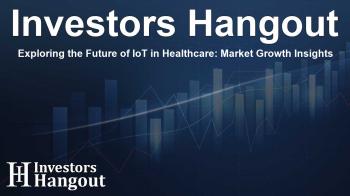Exploring the Future of IoT in Healthcare: Market Growth Insights

Future Growth of IoT in Healthcare
The global landscape of healthcare is undergoing a remarkable transformation, significantly propelled by the Internet of Things (IoT). The IoT in healthcare market is anticipated to reach an astounding USD 594.5 billion within a decade, illustrating a compound annual growth rate (CAGR) of 23.9%. This surge is largely attributed to the increasing adoption of connected devices, such as wearable health trackers and advanced AI solutions aimed at remote patient monitoring and enhanced healthcare experiences.
Key Growth Drivers in the IoT Healthcare Market
Wearable Technology and Smart Devices
Essentially, wearable technologies serve as pivotal players in the market, facilitating continuous patient monitoring through various tools, including smartwatches and implantable sensors. This technology enables real-time health data collection, empowering both patients and healthcare providers to monitor conditions promptly and effectively.
AI and Advanced Analytics
Artificial intelligence (AI) has become a game-changer in the healthcare sector. Through sophisticated analytics, healthcare professionals can leverage predictive algorithms that lead to timely diagnoses and efficient management of chronic diseases. This intelligent data interpretation enhances operational efficiency, leading to better patient care.
Telehealth and Remote Monitoring
Telehealth services are no longer just a convenience; they are a necessity. The integration of IoT and telehealth allows for seamless virtual consultations and remote care, enabling healthcare delivery to continue regardless of geographical limitations. This advancement supports not just patients in rural areas but also anyone seeking immediate assistance without the need for in-person consultations.
Investments in Smart Hospital Infrastructure
With the surge in IoT adoption, hospitals are increasingly investing in smart infrastructure. This includes automation systems and connected medical devices, which work together to enhance patient safety and improve workflow. By integrating IoT solutions, hospitals are better equipped to manage resources effectively while offering high-quality care.
Emerging Technologies and Patient Engagement
Smart Wearables and Personalized Care
The introduction of innovative IoT devices, such as AI-powered wearables, underlines the shift towards personalized healthcare solutions. Devices that utilize gesture control and AI-assisted monitoring create an engaging experience for users, promoting not only health tracking but also interaction and engagement in managing their conditions.
Opportunities for Executives and Investors
For industry leaders and investors, the burgeoning IoT in healthcare market presents a multitude of opportunities. There exists a significant potential to enhance patient outcomes, optimize hospital operations, and leverage data for informed health strategies. By adopting a forward-thinking approach to digital transformation, stakeholders can capitalize on high-growth sectors, including AI diagnostics and smart hospital solutions.
Strategies for Growth
Implementing robust social schemes for chronic disease management through remote monitoring taps into a growing demand for at-home healthcare. Investing in smart hospital technologies and forging strategic partnerships with telehealth providers are vital steps in expanding market shares. Enhancing cybersecurity measures and ensuring interoperability will be critical to building trust and fostering widespread adoption.
Addressing Challenges in IoT Adoption
Regulatory and Integration Hurdles
Despite the optimistic outlook, the growth journey for IoT in healthcare is not without challenges. The high cost of integrating IoT technologies with existing healthcare systems, alongside varying regulatory frameworks worldwide, presents hurdles that need addressing. Additionally, data privacy concerns and the need for compliance with standards such as HIPAA and GDPR necessitate careful navigation to ensure seamless deployment.
Conclusion
The future of healthcare is undoubtedly entwined with advancements in IoT technology. As healthcare systems progressively adopt connected care models, they are poised to achieve remarkable improvements in operational efficiency and patient care experience. The ability to monitor and manage health effectively using real-time data plays a crucial role in this ongoing transformation. Organizations that embrace these innovations will likely thrive in this competitive landscape, forging partnerships that drive mutual growth and success.
Frequently Asked Questions
What is the projected market value of IoT in healthcare?
The IoT healthcare market is expected to grow to USD 594.5 billion by 2035.
How does AI contribute to the IoT in healthcare?
AI enhances predictive analytics for better patient outcomes, optimizing care management.
What role do wearable devices play in healthcare?
Wearables enable continuous monitoring, providing real-time health data for better decision-making.
How can executives leverage IoT in healthcare?
Executives can enhance patient care, streamline operations, and foster partnerships through IoT integration.
What are the primary challenges in adopting IoT technologies?
Challenges include integration costs, regulatory compliance, and data privacy concerns.
About The Author
Contact Hannah Lewis privately here. Or send an email with ATTN: Hannah Lewis as the subject to contact@investorshangout.com.
About Investors Hangout
Investors Hangout is a leading online stock forum for financial discussion and learning, offering a wide range of free tools and resources. It draws in traders of all levels, who exchange market knowledge, investigate trading tactics, and keep an eye on industry developments in real time. Featuring financial articles, stock message boards, quotes, charts, company profiles, and live news updates. Through cooperative learning and a wealth of informational resources, it helps users from novices creating their first portfolios to experts honing their techniques. Join Investors Hangout today: https://investorshangout.com/
The content of this article is based on factual, publicly available information and does not represent legal, financial, or investment advice. Investors Hangout does not offer financial advice, and the author is not a licensed financial advisor. Consult a qualified advisor before making any financial or investment decisions based on this article. This article should not be considered advice to purchase, sell, or hold any securities or other investments. If any of the material provided here is inaccurate, please contact us for corrections.

